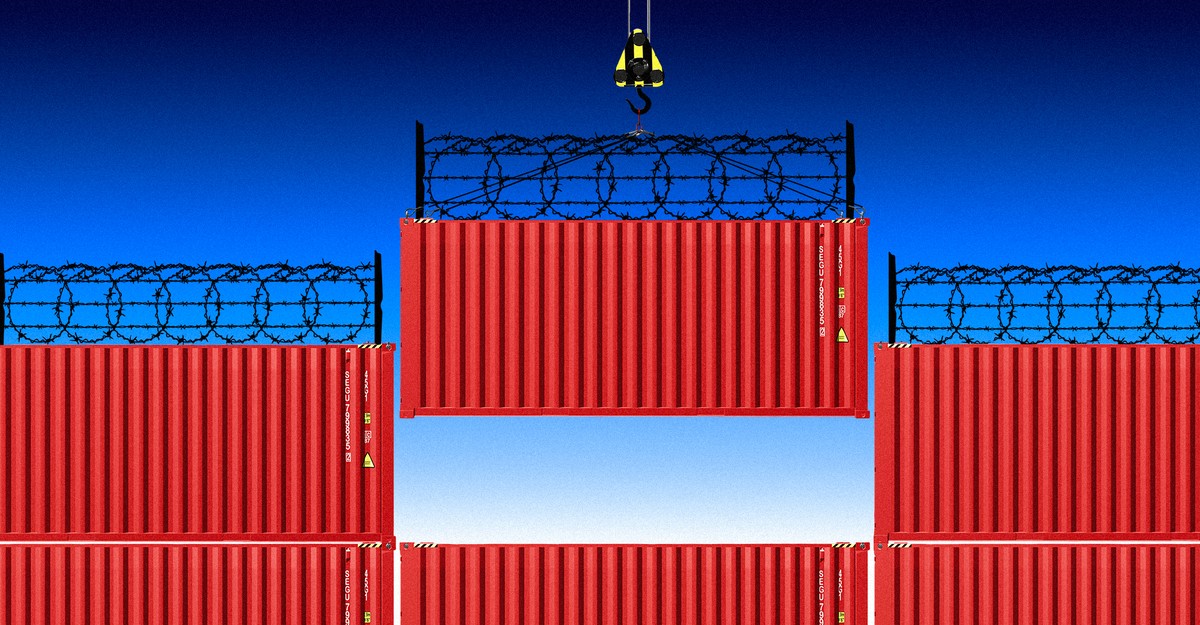You might have forgotten about the trade war, but the trade war has not forgotten about you.
This week, Donald Trump reignited the global financial conflict he started in January, sending letters threatening new tariff rates to nearly two dozen countries. Starting in August, American importers will pay a 25 percent tax on goods from South Korea and Japan, a 35 percent tax on goods from Canada and Bangladesh, and a 50 percent tax on goods from Brazil unless those countries agree to bilateral deals. Additionally, Trump warned he would slap tariffs on goods from any country “aligned” with the “Anti-American policies” of China, India, and other industrial powerhouses—no further details given—and put a 50 percent levy on imported copper, used to build homes, electronics, and utility systems.
The summer tariff announcement was characteristic of all the White House’s tariff announcements this year: draconian, nonsensical, and hard to take seriously. In his first weeks in office, Trump trashed the North American trade agreement that he had negotiated during his first term before exempting most goods coming from Canada and Mexico from border taxes. In April, the White House put high levies on goods from scores of American trading partners, only to announce a three-month “pause” on those levies shortly after. During the 90-day pause, American negotiators would craft 90 new trade deals, the White House promised.
This time, Trump did not make a formal trade announcement, opting instead to send error-laden form letters to foreign capitals (one addressed the female leader of Bosnia and Herzegovina as “Mr. President”). In a Cabinet meeting, he argued that “a letter means a deal,” adding that “we can’t meet with 200 countries. We have a few trusted people that know what they’re doing, that are doing a good job, but you can’t—you have to do it in a more general way, but it’s a very good way, it’s a better way. It’s a more powerful way.” (Even if a letter was a deal, which it isn’t, the Trump administration is more than 60 letters short of 90.)
The stock market shrugged at the letters; investors are now used to the president saying something nuts and then doing nothing. Traders have figured out how to make money from the short-lived dips that Trump periodically causes, calling it the “TACO trade,” for “Trump always chickens out.” But Trump is not doing nothing. Businesses are struggling to negotiate the uncertainty created by the White House. Trump’s tariffs are forcing up consumer costs and damaging firms. And the latest renewal of the trade war will make the economy worse.
Small businesses and companies reliant on imported goods from high-rate countries are struggling the most. A few weeks ago, I spoke with Jonathan Silva, the chief executive officer of WS Game Company. On our Zoom call, he sat in front of a howitzer-size, rainbow-colored Nerf gun, sporting a five-o’clock shadow and emanating a heavy-lidded weltschmerz. His 22-person business produces upscale versions of classic Hasbro board games: a pastel, tempered-glass Monopoly board; a turquoise-and-white Scrabble set reminiscent of Portuguese azulejo tile work; and a three-dimensional wooden Clue game that looks like a billiards table. The idea is to make board games “part of your lifestyle,” he told me, instead of stuffing them “in a cardboard box with tattered corners, falling apart at the top of your coat closet.”
The company produces its games in China, meaning that the fee it pays to import its goods has changed several times in the past six months, going as high as 145 percent. The time around Trump’s April “Liberation Day” tariffs was the “worst 45-plus days of our company’s history,” Silva told me. His company put in place a spending freeze: halting bonuses, barring new hires, and cutting all unnecessary business expenses. “The main goal was to keep every employee that we have employed,” Silva told me. Then the company raised prices. “We tried to sell whatever we had domestically in our warehouses to free up cash and give us as long of a runway as possible,” he said. Even so, the company lost $16 million in purchase commitments from its sticker-shocked retailers.
The disruption from the spring will affect the rest of the business’s year, and, in particular, its crucial holiday-sales season, Silva told me. “It’s about 150 days from when I place an order to when it might hit the shelves,” he explained. “When the supply chain gets put on pause for four to six weeks, getting back on schedule takes a year.” That happened in a more extreme fashion during the early days of the coronavirus pandemic.
This year, “the shelves might be filled with products for the holiday, but they might not be filled with the products that the retailers really want to put on the shelf,” Silva said. “The consumer might not notice, but the businesses do.”
Businesses thus far have sheltered American consumers from tariffs by eating some of the cost themselves and relying on stockpiled goods. As a result, inflation has remained subdued and economic growth strong enough through the first half of the year. But firms can keep only so much stock in warehouses. Analysts at BNP Paribas, a banking group, estimate that inventories will “clear” by the end of the summer, and prices will rise in turn. Right now, American consumers are facing an 18 percent effective tariff rate, the highest since 1934, the Yale Budget Lab estimates. Households will pay an average of $2,400 more for goods this calendar year, thanks to Trump’s policies.
Thousands of businesses are again negotiating extremely high and haphazardly implemented rates on goods from any number of crucial trading partners. South Korea sends billions of dollars of heavy machinery to the United States each year. Bangladesh ships billions of dollars of clothing. (Clothes and shoes will see the biggest price increases because of the trade war, the Yale analysts found; prices on these goods are expected to rise roughly 40 percent.) Canada is the United States’s second-largest trading partner, an important source of farm equipment, auto parts, minerals, and crops. And companies will have to negotiate whether to work in the cost of the new tariffs or to make their own TACO trades, assuming that the Trump administration will fold and cut rates again.
History suggests that this is exactly what Trump will do, especially if the market tanks. But who knows? This week, a reporter asked the president whether new tariff rates would take effect on July 9, the end of the 90-day pause, or on August 1, the date indicated in the letters.
“What are you talking about?” Trump asked.
The tariff rates, the reporter said.
The president provided some clarification: “They’re going to be tariffs. The tariffs are going to be the tariffs.”
From The Atlantic via this RSS feed
This fucktard will not be happy until he’s absolutely ruined this country. Putin must be happy his investment paid off


